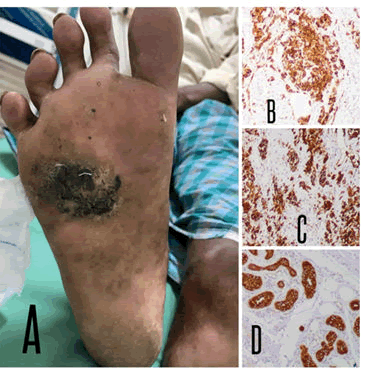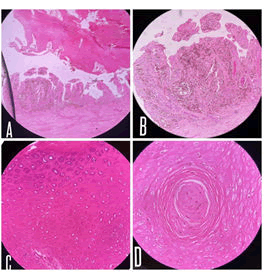Case Report - (2021) Volume 9, Issue 11
Malignant Melanoma or Pigmented Squamous Cell Carcinoma? A Diagnostic Enigma
Shreya Srinivasan*, Vignesh NR, Sivaramakrishnan.S and K. Manoharan
*Correspondence: Shreya Srinivasan, Department of Dermatology, Venereology and Leprosy, Sree Balaji Medical College and Hospital, Chennai, Tamil Nadu, India, Email:
Abstract
Malignant melanoma, a neoplasm of the melanocytes must be closely differentiated from pigmented squamous cell carcinoma and pigmented basal cell epithelioma which are less invasive in comparison. We report a case of acral melanoma, wherein histopathology showed a horn pearl in addition to features of melanoma. Immunohistochemistry clinched the diagnosis thus revealing its utmost importance in diagnostics and we have reported this case to highlight the importance of a thorough clinical and laboratory work-up in any suspected case of melanoma since it is a highly invasive condition which requires aggressive therapy.
Keywords
Acral melanoma, Pigmented squamous cell carcinoma, Horn pearl, Immunohistochemistry
Introduction
Malignant melanoma, a neoplasm of the melanocytes must be closely differentiated from pigmented squamous cell carcinoma and pigmented basal cell epithelioma since it is a highly invasive condition as opposed to the less invasive differentials. We report a case of malignant melanoma, wherein histopathology showed a horn pearl in addition to features of melanoma. Immunohistochemistry clinched the diagnosis thus revealing its utmost diagnostic importance and we have reported this case to highlight the importance of a thorough clinical and laboratory work-up in any suspected case of melanoma [1].
Case Report
A sixty-two-year-old man came to our out-patient department (OPD) with complaints of a pigmented lesion over the right sole associated with pain and mild bleeding for the past five months. The patient noticed a discolored patch two years ago and did not resort to any treatment for the same [2]. He presented to our OPD since he developed increase in size and associated pain as well as bleeding which were present during the last five months. On examination, the lesion was present over the right sole measuring about five x three centimeters with irregular borders and irregular pigmentation over the plaque (Figure 1).

Figure 1: A-Clinical image of the right sole showing an irregular pigmented plaque with mild ulceration in the middle. B-Immunohistochemistry with strong Melan-A positivity. C- Immunohistochemistry with strong HMB-45 positivity. D- Immunohistochemistry with mild PANCK positivity. There was a small area of ulceration
There was a small area of ulceration noted within the lesion. The whole body was examined to look for lesions like lentigines and any metastasis. Lymph node examination was performed clinically and was found to be insignificant. Suspecting a clinical diagnosis of malignant melanoma, an excisional biopsy was performed with a two-centimeter tumor margin. An ultrasound abdomen and computed tomography (CT) of the chest were normal showing no nodes or metastases. The patient was not evaluated further for sentinel lymph node examination and metastasis as he was not cooperative [3].
Histopathology revealed epidermal and dermal nests of melanoma cells or atypical epithelioid melanocytes with some areas exhibiting a pagetoid or buckshot spread [4]. A horn pearl typical of squamous cell carcinoma, containing numerous pigmented cells was seen, confusing the presentation, leading us to consider a differential of pigmented squamous cell carcinoma. Breslow’s thickness was two millimetres (Figure 2).

Figure 2: A- Haematoxylin and Eosin (H and E) stain in 10x magnification showing dermal and epidermal nests of melanoma cells. B - H and E stain in 10x magnification showing epidermal and dermal nests of melanoma cells. C- H and E stain in 40x magnification showing pagetoid spread of the melanoma cells. D-H and E stain showing the horn pearl formation.
Immunohistochemistry clinched the diagnosis of malignant melanoma by revealing strongly positive HMB-45 and Melan-A stains. While panCK was also positive, there was no evidence of strong staining.
Pigmented squamous cell carcinoma is commonly seen over the sun-exposed sites of the body and histopathology will show massive hyperplasia with nests of atypical cells, horn pearls and dendritic melanocytes without atypia. In addition, immunohistochemistry will reveal strong cytokeratin staining [5].
A diagnosis of malignant melanoma was made, as other than the horn pearl, the site, histopathology and immunohistochemistry were strongly against pigmented squamous cell carcinoma. Some authors, have reported that ten percent of melanomas express cytokeratin positivity and our case can also be included in the same.
Dicussion
Malignant melanoma is a malignant tumor of the melanocytes commonly encountered in the fair skinned population, though acral melanoma can occur in dark-skinned individuals. The tumor can arise de-novo as well as from chronic or intermittent sun exposure. Genetic factors also play a role in the development of the tumor, like mutations in the RAS-RAF-MEK-ERK signaling pathways. Early diagnosis of this tumor is important considering the mortality of the tumor at later stages [3].
Acral melanoma also known as acral lentiginous melanoma occurs over the hands and feet, involving the palms, soles, fingers, toes and the entire nail unit. Though it is the commonest type of melanoma in dark skinned individuals, it is the least common of all melanomas.
Clinically, it begins as a pigmented macule which progresses to a macule, plaque and nodule with variable brown, blue or black pigmentation, sometimes within the same lesion. The edges are usually irregular, sometimes angular and follow the dermatoglyphic ridges. Long standing lesions typically end up in ulceration and bleeding [1].
“CUBED” approach is a classical acronym utilized in acral melanoma and stands for Color, Unclear/Uncertain diagnosis, Bleeding, Enlargement of the lesion and Delayed healing beyond two months.
Involvement of the nail unit will result in extension of the lesion over the proximal nail fold and this is known as Hutchinson’s sign. Dermoscopy is a valuable tool which can aid in the diagnosis of melanoma and will reveal asymmetry of structure and colors, variation in the patterns of pigmentation and most importantly, a parallel ridge pattern. Histopathology of an acral melanoma will reveal a broad radial growth phase which is in-situ. Atypical melanocytes can be seen predominantly at the dermo-epidermal junction with advanced cases showing the atypical cells in nests. Pagetoid spread can be seen at the peripheral edges and within the ridges. An atypical melanocyte is characterized by the variation in size and shape as well as nuclear hyperchromasia. Long standing lesions can lead to invasion of the dermis resembling a superficial spreading melanoma [4].
It is imperative that a lymph node examination along with sentinel lymph node biopsy, chest radiograph, CT, ultrasound, whole body positron emission tomography (PET) scan and a radiological examination are done as melanoma is a highly metastatic condition and can metastasize to various systems like the lungs, liver, bone and brain [5].
Mainstay of treatment, especially in acral melanoma is excision with the clinical margin depending on the Breslow’s thickness. Radiation therapy and chemotherapy in the form of dacarbazine, BRAF inhibitors like vemurafenib and tyrosine kinase inhibitors like imatinib may be required especially in cases of metastasis [3].
Conclusion
Malignant melanoma requires a high degree of suspicion especially in confounding cases as this, as it is a highly invasive tumor with increased risk of metastasis to various systems and hence requiring aggressive treatment. A scrupulous history and clinical examination along with dermoscopy, histopathology and immunohistochemistry are indispensable towards making a diagnosis of malignant melanoma and ruling out pigmented squamous cell carcinoma, as seen in our case.
References
- Plaza JA, Suster D, Perez-Montiel D. Expression of immunohistochemical markers in primary and metastatic malignant melanoma: A comparative study in 70 patients using a tissue microarray technique. Applied Immunohistochem Mol Morphol. 2007; 15:421-425.
- Yajima I, Kumasaka MY, Thang ND, et al. RAS/RAF/MEK/ERK and PI3K/PTEN/AKT signaling in malignant melanoma progression and therapy. Dermatol Res Practice. 2012.
- Bristow IR, de Berker DA, Acland KM, et al. Clinical guidelines for the recognition of melanoma of the foot and nail unit. J Foot Ankle Res. 2010; 3:1-3.
- Benati E, Ribero S, Longo C, et al. Clinical and dermoscopic clues to differentiate pigmented nail bands: an International Dermoscopy Society study. J Euro Acad Dermatol Venereol. 2017; 31:732-736.
- Saida T, Miyazaki A, Oguchi S, et al. Significance of dermoscopic patterns in detecting malignant melanoma on acral volar skin: Results of a multicenter study in Japan. Arc Dermatol. 2004 ; 140:1233-1238.
Author Info
Shreya Srinivasan*, Vignesh NR, Sivaramakrishnan.S and K. Manoharan
Department of Dermatology, Venereology and Leprosy, Sree Balaji Medical College and Hospital, Chennai, Tamil Nadu, IndiaCitation: Malignant Melanoma or Pigmented Squamous Cell Carcinoma? A Diagnostic Enigma, J Res Med Dent Sci, 2022, 9(11):411-413
Received: 04-Oct-2021 Accepted: 18-Oct-2021 Published: 25-Oct-2021
